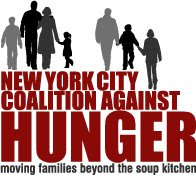Amid economic instability, food stamp enrollment in the U.S. is expected to hit 28 million in the coming fiscal year, up from 27.8 million this year. 14 states have already reached record enrollment, while 40 reported an increase in recipients in the past year. Though food stamp enrollment in
Providing news and commentary on issues facing the City's anti-hunger community

The New York City Coalition Against Hunger represents New York City’s over 1,200 soup kitchens and food pantries and the 1.3 million low income New Yorkers who are forced to use them. The Coalition works to meet the immediate food needs of low-income New Yorkers and enact innovative solutions to help them move “beyond the soup kitchen” to self-sufficiency.
Blog Archive
-
▼
2008
(116)
-
▼
April
(19)
- Amid Growing Inequities, Wall Street Journal Tells...
- Rice Rations Indicate Further Trouble for Food Eco...
- Calorie Posting Law Brings a Shot of Nutritional R...
- Courting Supermarkets, City Turns to Pennsylvania ...
- Despite Deadlines Farm Bill Debate Proves Intermin...
- CSAs Offer Mutual Benefit for Farmers and Low-Inco...
- Judge Upholds Decision To Require Calorie Postings
- 50 city green carts to roll out fruit, veggies for...
- Rampant inflation on grocery aisles prompting city...
- Complexity be damned: the Farm Bill explained
- Food Costs Rising Fastest in 17 Years
- State Cuts Hunger Funding by 16% Despite Current F...
- Consumers Edit Grocery Lists as Prices Soar
- PBS Hunger Series Will Feature Brooklyn Pantry
- Bringing Food to the Presidential Race
- Executive Director Berg Urges Council’s Commitment...
- With Lack of Food Comes Loss of Choice
- Consistent Healthy Eating Linked to Academic Achie...
- As Food Stamp Enrollment Rises, a Call for Accurat...
-
▼
April
(19)
No comments:
Post a Comment